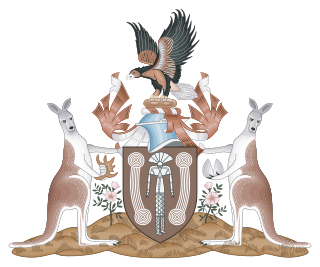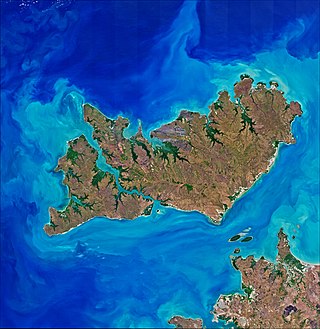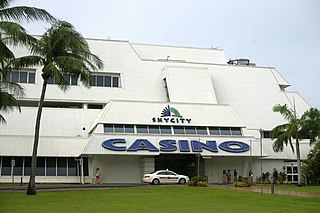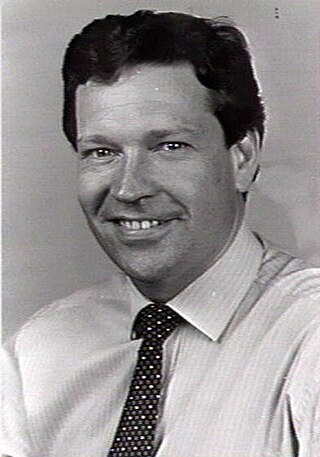Related Research Articles

Darwin is the capital city of the Northern Territory, Australia. With a population of 139,902 at the 2021 census, the city contains most of the sparsely populated Northern Territory's residents. It is the smallest, wettest, and most northerly of the Australian capital cities and serves as the Top End's regional centre.

The Northern Territory is an Australian territory in the central and central northern regions of Australia. The Northern Territory shares its borders with Western Australia to the west, South Australia to the south, and Queensland to the east. To the north, the territory looks out to the Timor Sea, the Arafura Sea and the Gulf of Carpentaria, including Western New Guinea and other islands of the Indonesian archipelago.

The Jervis Bay Territory is an internal territory of Australia. It was established in 1915 from part of New South Wales (NSW), in order to give the landlocked Australian Capital Territory (ACT) access to the sea.
Eminent domain, land acquisition, compulsory purchase, resumption, resumption/compulsory acquisition, or expropriation is the power of a state, provincial, or national government to take private property for public use. It does not include the power to take and transfer ownership of private property from one property owner to another private property owner without a valid public purpose. This power can be legislatively delegated by the state to municipalities, government subdivisions, or even to private persons or corporations, when they are authorized by the legislature to exercise the functions of public character.

The Legislative Assembly of the Northern Territory is the unicameral legislature of the Northern Territory of Australia. The Legislative Assembly has 25 members, each elected in single-member electorates for four-year terms. The voting method for the Assembly is the full-preferential voting system, having previously been optional preferential voting. Elections are on the fourth Saturday in August of the fourth year after the previous election, but can be earlier in the event of a no confidence vote in the Government. The most recent election for the Legislative Assembly was the 2020 election held on 22 August 2020. The next election is scheduled for 24 August 2024.

Bathurst Island is one of the Tiwi Islands in the Northern Territory off the northern coast of Australia along with Melville Island.
A land grant is a gift of real estate—land or its use privileges—made by a government or other authority as an incentive, means of enabling works, or as a reward for services to an individual, especially in return for military service. Grants of land are also awarded to individuals and companies as incentives to develop unused land in relatively unpopulated countries; the process of awarding land grants are not limited to the countries named below. The United States historically gave out numerous land grants as Homesteads to individuals desiring to prove a farm. The American Industrial Revolution was guided by many supportive acts of legislatures promoting commerce or transportation infrastructure development by private companies, such as the Cumberland Road turnpike, the Lehigh Canal, the Schuylkill Canal and the many railroads that tied the young United States together.

Mindil Beach Casino & Resort is a casino in Darwin, Northern Territory, Australia, owned and operated by Delaware North. It is the only casino in Darwin.
Section 51(xxxi) is a subclause of section 51 of the Constitution of Australia. It empowers the Commonwealth to make laws regarding the acquisition of property, but stipulates that such acquisitions must be on just (fair) terms. The terms is sometimes referred to in shorthand as the 'just terms' provision.

The North Australia Railway was a 509 km (316 mi) 1,067 mm narrow gauge railway in the Northern Territory of Australia which ran from the territory capital of Darwin, once known as Palmerston, to Birdum, just south of Larrimah. Initially its name was the Palmerston and Pine Creek Railway. The first section was opened 1889, the last in 1929. The railway closed in 1976.

Charles Lydiard Aubrey Abbott was an Australian politician and administrator of the Northern Territory. He was born at St Leonards, Sydney, to Thomas Kingsmill Abbott, a magistrate, and Marion, née Lydiard. He came from a political family – his uncles, Sir Joseph Abbott and William Abbott, had served in the New South Wales Legislative Assembly, while his cousins, Joe Abbott and Mac Abbott, would later enter Federal parliament.
Southport is an outer rural locality in Darwin. It is based on the site of the abandoned Town of Southport, a thriving river port during the Pine Creek gold rush of the 1870s. It is located at the junction of the Blackmore and Darwin Rivers.

The Darwin rebellion of 17 December 1918 was the culmination of unrest in the Australian Workers' Union which had existed between 1911 and early 1919. Led by Harold Nelson, over 1,000 demonstrators marched on Government House at Liberty Square in Darwin, Northern Territory, Australia where they burnt an effigy of the Administrator of the Northern Territory, John Gilruth, and demanded his resignation.

John Edward Reeves is a former Australian politician, lawyer and judge. He was a Labor member of the Australian House of Representatives from 1983 to 1984, a prominent barrister in Darwin afterwards, the author of the controversial 1999 Reeves Report on Aboriginal land rights in Australia. He served as a Judge of the Federal Court of Australia from November 2007 to January 2022.

Chinatowns in Australia is a term used to describe major Chinese ethnic enclaves in Australia, especially those that claim to retain a strong Chinese cultural identity and a strong relationship with China. Chinatowns exist in most Australian states and territories, especially in the highly-populous and cosmopolitan capital cities but also in rural areas. Many large present-day Chinatowns in Australia have developed out of smaller historical Chinese settlements in Australia dating back to the 19th century. Chinese people first immigrated to Australia in large waves in the midst of the Australian gold rushes. Many of these people subsequently chose to return to China or were forcefully deported from Australia. The first known Chinese Australian was John Shying, who immigrated to Australia in 1818.
Timber Creek, traditionally known as Makalamayi, is an isolated small town on the banks of the Victoria River in the Northern Territory of Australia. The Victoria Highway passes through the town, which is the only significant settlement between the Western Australia border and the town of Katherine to the east. Timber Creek is approximately 600 kilometres (370 mi) south of Darwin, in an area known for its scenic escarpments and boab trees.
During the 19th century and early 20th century, San Jose, California, was home to a large Chinese-American community that was centered around the Santa Clara Valley's agricultural industry. Due to anti-Chinese sentiment and official discrimination, Chinese immigrants and their descendants lived in a succession of five Chinatowns from the 1860s to the 1930s:
The history of Chinese after those from the British Isles. Significant Chinese emigration only began in earnest after the discovery of gold and the subsequent gold rushes in Australia. This migration shaped and influenced Australian policies on immigration for over a century. Despite facing societal discrimination and restrictive immigration policies, Australians of Chinese descent have
Section 122 of the Constitution of Australia deals with matters relating to the governance of Australian territories. It gives the Commonwealth Parliament complete legislative power over the territories. This power is called the territories power. The extent and terms of the representation of the territories in the House of Representatives and the Senate are also stated as being at the discretion of the Commonwealth Parliament.

Gloria Ouida Lee or Siew Yoke Kwan, also known as Gloria Purdy-Lee was a Chinese-Australian miner. She was the daughter of Alice Springs Chinese Market gardener Ah Hong and his Western Arrernte wife Ranjika. Lee travelled between Australia and China and experienced discrimination because of her mixed parentage. She is included in the archive collection of the Women's Museum of Australia, formerly known as the National Pioneer Women's Hall of Fame. Her oral history is held at the National Library of Australia.
References
- ↑ Tseen Khoo (2003). Banana bending: Asian-Australian and Asian-Canadian literatures. ISBN 9780773525511.
- ↑ Regina Ganter, Julia Martínez (2006). Mixed relations: narratives of Asian/Aboriginal contact in North Australia. ISBN 9781920694418.
- ↑ Giese 1995, p. 35.
- ↑ Giese 1995, p. 37.
- ↑ Giese 1995, p. 36.